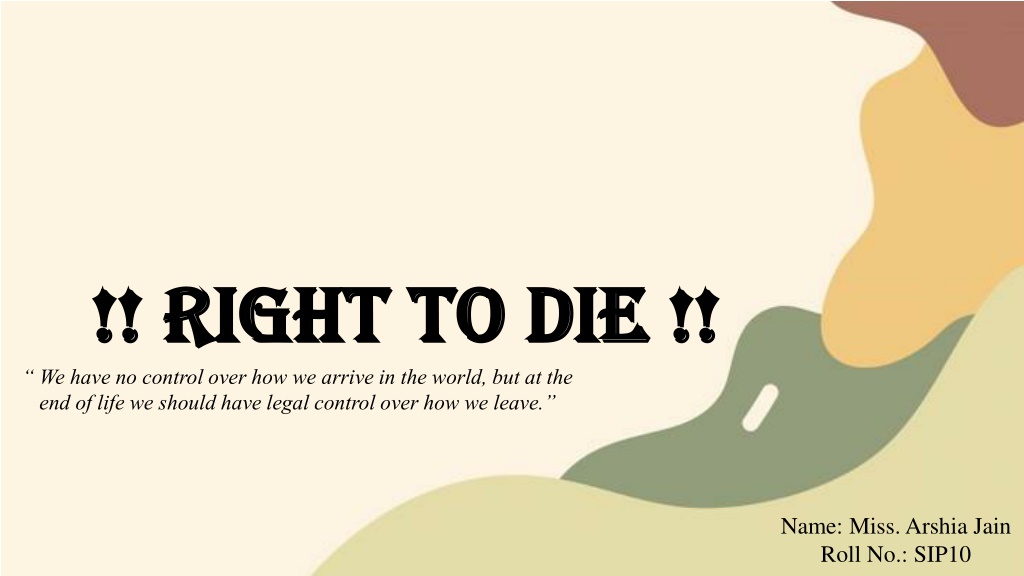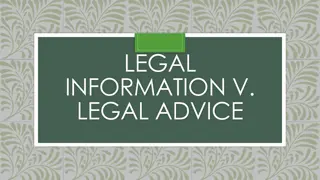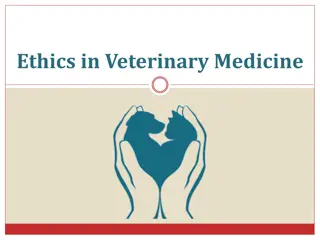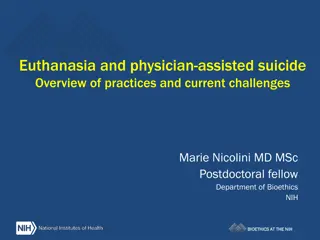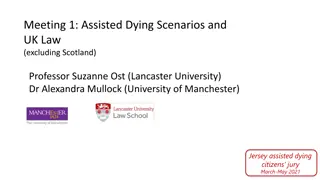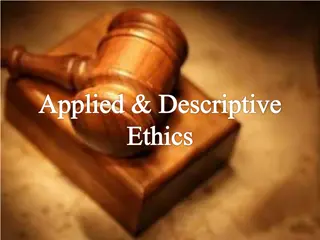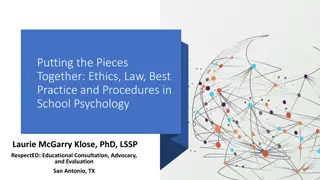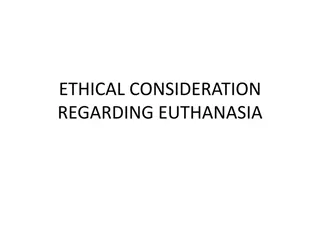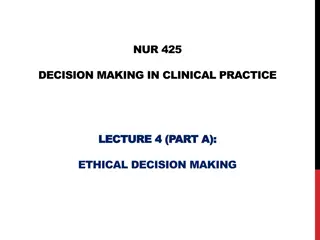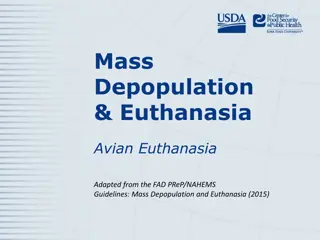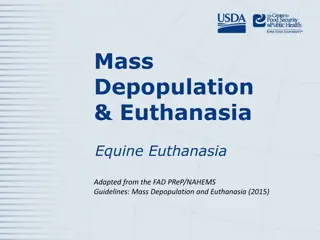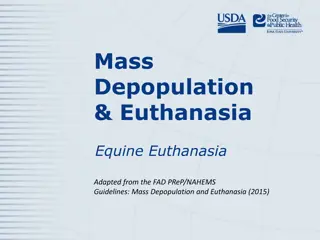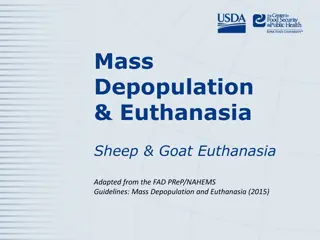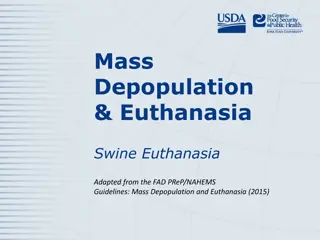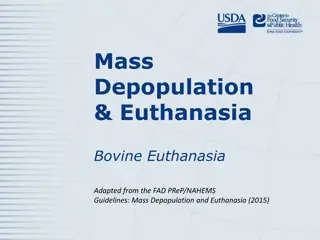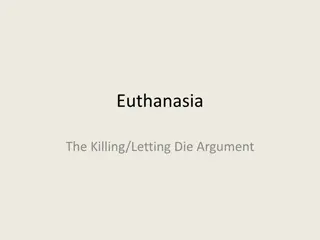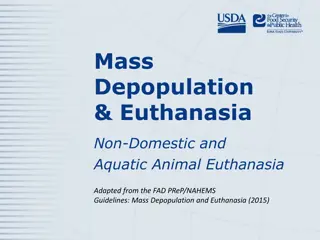Understanding Euthanasia: A Legal and Ethical Perspective
The presentation delves into the complex topic of euthanasia, exploring its various forms, historical context, and legal considerations. It discusses the evolution of attitudes towards euthanasia, highlighting landmark legal cases and the ongoing debate between legality and morality. The concept of patient autonomy and the right to a dignified death are central themes. Through a detailed examination, the presentation aims to shed light on the constitutionality of euthanasia and the diverse perspectives surrounding this sensitive issue.
Download Presentation

Please find below an Image/Link to download the presentation.
The content on the website is provided AS IS for your information and personal use only. It may not be sold, licensed, or shared on other websites without obtaining consent from the author. Download presentation by click this link. If you encounter any issues during the download, it is possible that the publisher has removed the file from their server.
E N D
Presentation Transcript
!! RIGHT TO DIE !! !! RIGHT TO DIE !! We have no control over how we arrive in the world, but at the end of life we should have legal control over how we leave. Name: Miss. Arshia Jain Roll No.: SIP10
The ppt talks about how: The ppt talks about how:- - Euthanasia is seen as a conundrum due to the presence of many conducts justified on several grounds. Not only the views on euthanasia differed based on religion but also on factors like education, age and gender. There has been a long history of multiple cases on this issue. Finally, in the landmark case of Common Cause v. Union of India, the Apex Court pronounced to legalize passive euthanasia in the country. The judgement gave a robust interpretation of Article 21 of the constitution. The court held that passive euthanasia is not an offence under IPC. Neither the patient is liable under Section 306 nor the doctors are liable under Section 309 of IPC. The judgement faced both approbation and criticism. Further, this article proposes to talk about euthanasia, its types, historical background and the legal aspect of it. It discusses the constitutionality of euthanasia and the present scenario of the country.
INTRODUCTION: INTRODUCTION:- - The progress and evolution in technology and medical science have not only improved the general human health by completely demolishing the epidemics, but have also found the cure for others. They have interfered with the natural life span of people by finding treatments and drugs for prolonging it. If a person is suffering due to incurable illness, patient's autonomy should supersede everything. A person has all the rights over his decision, be it regretting over the bad choices or rejoicing over the good ones. Euthanasia is defined as an intentional termination of a patient's life by an or omission of medical care. The constitutionality of euthanasia has been a much-debated issue throughout the world. Controversy between legality and morality has been significant phenomenon during the past decades. The constitutionality of euthanasia was always a subject of dispute. Euthanasia is not an offence. It is an end to the excruciating sufferings and agony of a terminally ill patient. The dignity of a person cannot be effaced by sickness or sufferings. Each nation decides whether they should legalize euthanasia or not.
BACKGROUND: BACKGROUND:- - Euthanasia is a way of ending the life of a person to provide relief from distress and unbearable conditions. It is done to ensure painless death to a person when there are no hopes for improvement. The word euthanasia is derived from the Greek word, EU and Thanatos which means good death and easy death. Several countries across the world have legalized euthanasia.
The different types of euthanasia are: Active or Passive Euthanasia: It involves giving lethal medicines to a patient suffering from an incurable disease to end his life painlessly. Passive or Negative Euthanasia: Passive euthanasia involves removing the life-saving devices or to stop giving the medication. It is a way of ending life through a natural means. It means a process in which the doctor is not saving a patient. Voluntary Euthanasia: In this type, the consent of the patient matters. Euthanasia is performed only with the permission and the expressed desire of the patient. It is performed when it is in the best interest of the patient and also everyone else. Involuntary Euthanasia: Euthanasia is performed without the consent of the patient. The patient is killed against his wish, and it amounts to an offence. Non-Voluntary Euthanasia: In non-voluntary euthanasia, the deceased or the patient is not competent to inform someone about his request to die or request to live. In addition to this, the patient also neither made a living will nor he has given any advance directives. The euthanasia is performed with the consent of his family members and their decision is respected.
CONFLICTING CONCEPTS ON CONFLICTING CONCEPTS ON EUTHANASIA: EUTHANASIA:- - In several texts of Hindus and even ancient Greeks instances have been found where the killing of a person suffering from an incurable disease is favoured. In epic pieces of literature like Mahabharata and Ramayana, there are several instances of religious suicides. According to Hindu texts, ending a life of a person suffering from a painful disease is considered a good deed. Some other Hindu texts believe that by ending a person's life, one is disturbing the cycle of death and rebirth. Further, Muslims were against euthanasia. They considered life to be sacred and believed that no one has a right to interfere with the health of a person. Sikhs were also not in favour of euthanasia as they considered it to be an interruption in God's plan.
It has been found that opinions of people also differ on euthanasia on factors like religion, age, sex, education or status. People who are more religious as compared to others are often against euthanasia. A college student will favour euthanasia more than a non-educated person. Different countries have different ideologies regarding euthanasia. India has legalized only passive euthanasia while active euthanasia is still illegal in the country. Stanley Leo says that life is not only about surviving but also living a life with good health. There have always been deliberations on this subject for a few decades. Some people were against euthanasia, and some wanted to legalize it. Suicide is an act performed by the person himself to end his life. Euthanasia is performed with the consent of the deceased person.
HISTORY OF EUTHANASIA: HISTORY OF EUTHANASIA:- - Since the Maneka Gandhi case, such activism has widened the scope of Article 21. The Supreme Court of India has passed a plethora of judgments before the legalization of Passive Euthanasia in the country. There have been an evolution and differences in the legality of euthanasia from one judgment to others. Euthanasia is a dilemma due to presence of more than one course of conduct justified on various grounds. The right to die is a negative right of right to life and have been a subject of dispute since a long time in Indian judiciary. The legal barrier in recognizing the right to dying are Section 306 and 309 of IPC. The first judgement which dealt with the issue that whether the right to die is included under Article 21 of the constitution was Maruti Shripati Dubal v. State of Maharashtra. Subsequently, the Apex Court in P Rathinam v Union of India held that under Article 21, the right to life does not include the right to die.
It coincided with the judgment of the Bombay High Court in the case Maruti Shripati Dubal v. State of Maharashtra and held that Section 306 and 309 are unconstitutional, on the grounds of being violative of Art. 21, which includes the right to die. Supreme Court in 1996 in Gian Kaur v. the State of Punjab pronounced the judgment that both active and passive euthanasia and assisted suicide is unlawful in India. It was also challenged that as the court in the P Rathinam case has invalidated Section 309 of IPC, therefore the Section 306 which penalizes abetment of suicide should also be held unconstitutional ipso facto. But the court rejected this argument and held that both Section 306 and IPC are valid and constitutional. In 2011, the Apex Court in Aruna Shanbaug v. Union of India relying on the above judgment, held that passive euthanasia is legally valid in the country under exceptional circumstances. The Law Commission of India gave a clear definition and clarified the meaning of the terms related to euthanasia. The report also recommended passive euthanasia in cases where the deceased is both capable and incapable of deciding things.
COMMON CAUSE V. UNION OF INDIA: COMMON CAUSE V. UNION OF INDIA:- - The Supreme Court gave a landmark verdict making the way for passive euthanasia. The Court reiterated that the right to die with dignity is a fundamental right. The 538-page judgment was delivered by the five-judges' constitutional bench. Passive euthanasia is considered morally superior to active euthanasia since it means allowing the patient to die and not killing him. The judgment has paved the way for the terminally ill patients to seek death through the passive. euthanasia under a "living will". Euthanasia has been derived. from the Greek word "euthanatos", which means "good death". There are two ways to seek euthanasia viz. passive and active. In passive euthanne, there is withdrawal of medical treatment of terminally. ill patients, whereas, in active euthagna, injections or overdose of. medicines are given to hasten their death, which is illegal in India. The verdict paved the way for the 'living will' of a patient to record his wish that he should not be kept alive with the help of ventilators, if doctors, at any stage of his life, opine that he cannot be kept. alive without life support system.
PRESENT SCENERIO AND PRESENT SCENERIO AND LIABILITY OF DOCTORS: LIABILITY OF DOCTORS:- - Life-supporting system can be stopped if there are no hopes for a patient's recovery. The question arises whether by doing this, can the medical practitioner be guilty of abetment to suicide or murder? This issue has been a matter of concern in many countries. The Law Commission of India in its 196th report annexed the drafted Bill named "Medical Treatment of Terminally Ill Patients (Protection of Patients and Medical Practitioners) Bill, 2006. The Court held that a competent patient has every right to decide what is good for him and what is wrong. A patient can decide for himself whether he wants medical treatment or allow the disease to continue. The law is incredibly crucial to know the exact meaning of terms like 'competent', 'incompetent' and 'best interest' . It is incredibly important to know that the law in India does not consider this act of patient as any offence. The patient can be held liable under Section 309 of IPC if he is an adult, competent enough and refuses treatment. Section 309, however, talks about 'attempt to commit suicide' and the law says that a patient can choose to stop medication if he considers it to be in his best interest. Also, in Airedale[37]the House of Lords held that it is not suicide. Supreme Court had also declared that this is not an offence under Section 309 of IPC. If a doctor obeys the instruction of the patient of not giving him the medicines or medical treatment, then he is not committing any offence. There were disputes related to the doctors being guilty under Section 299 of I PC, which talks about 'culpable homicide' which is lacking in this case.
CONCLUSION: CONCLUSION:- - End-of-life issues are becoming primary ethical considerations in the modern-day medical science in India. Euthanasia is an incredibly disputable issue in a country like India, where even attempting to commit suicide is an offence. After studying and analysing various aspects of euthanasia in detail, it can be concluded that passive euthanasia is constitutionally valid. Neither it is going against any fundamental right, nor can it be considered as an offence under the Indian Penal Code. The Judiciary has taken an applaudable step by legalizing Passive euthanasia and making illegal the active euthanasia. The Court in further judgments held that Article 21 includes both right to die with dignity and right to life. Life is a gift of God and one should take all possible measures to save it. Life should not be studied in isolation rather it must be the part of Article 21 of the constitution. The 'liberty to die' should not. be studied as a matter of isolation but must be the part. of Article21. Passive euthanasia is based on the consent and the will of a patient. It is only performed in a case where the person is suffering from an incurable disease. The strict guidelines attached to it is protecting its misuse.
THANK THANK YOU YOU
